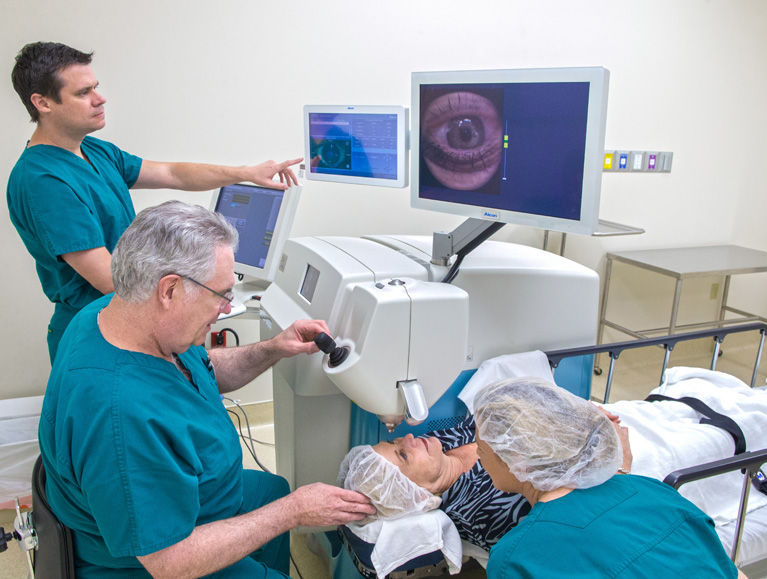
Sitting down to talk with Dr. Paul Minotty, who heads the New Vision Eye Center in Vero Beach, about his brand-new Verion™ Image Guided System for cataract surgery is not unlike sitting under a waterfall of eye care information: In more ways than one.
First, the word “cataract” itself comes from the Latin word for waterfall. Just as rapidly running water turns white or cloudy, cataracts in the eye turn a patient’s vision white and cloudy before, eventually, stealing that patient’s sight altogether.
Secondly, Minotty himself is something of a fountain of information and experience in more phases of ophthalmology than most folks probably knew existed. The Johns Hopkins and University of Miami School of Medicine graduate did his internship at University of Miami Affiliated Hospitals before completing his residency at the Greater Baltimore Medical Center where he was chief resident.
Minotty is certified in cataract/implant surgery by the American Board of Eye Surgeons, is a Fellow of the American College of Surgeons and a Diplomate of the American Board of Ophthalmology. He is also a Clinical Assistant Professor the Florida State University College of Medicine. In 1985 Minotty founded the Florida Eye Institute in Vero Beach and in 2009, he founded Vero Beach’s New Vision Eye Center.
Minotty is clearly excited about his new Verion™ system and the fact that New Vision is the first – and only – practice on Florida’s east coast currently employing this new technology.
“Basically what we’re talking about,” says Minotty, “is game-planning for cataract surgery.”
Cataracts are the single most common cause of vision loss in people over 40 years of age. They are also the principal cause of blindness worldwide. Indeed, there are more cases of cataracts than there are of glaucoma, macular degeneration and diabetic retinopathy combined, according to Prevent Blindness America.
So what is a cataract? It might help to think of your eye as a camera. Light enters the eye, passes through the cornea and the aqueous humor (that transparent fluid in the front of the eye), to the pupil and into the lens. The lens then bends the light to focus objects onto the retina in the back of the eye. From there, the image passes through the retinal cells to the optic nerve and finally to the back of the brain which process the images.
Cataracts occur when there is a buildup of proteins on the lens that make it cloudy. This prevents light from passing clearly through. New lens cells then form on the outside of the lens and all the older cells are compacted into the center of the lens creating the cataract.
Today, cataracts affect more than 23 million Americans and Minotty says that here in Vero Beach, “cataract surgery makes up about 25 percent” of New Vision’s practice.
So, it might be logical to presume that the reason for adding the new Verion™ hardware and software to New Vision’s arsenal was to speed up the cataract surgical process but Minotty says that’s not the case. “In fact,” he says leaning forward, “it actually takes a little longer.”
What seems to delight him most about his new system is its accuracy while adding that, “the key is that we’re now customizing procedures for every patient” more efficiently.
Remember that fountain of eye care information? Minotty stopped and stepped back in time some 75 years to tie his new Verion™ system to an ophthalmologic legend, Sir Harold Ridley.
Ridley was an ophthalmologist who treated Royal Air Force pilots with eye injuries during World War II. He was also the first to notice that when splinters from the acrylic plastic cockpit canopies of British fighter planes lodged in the eyes of wounded pilots, they did not trigger a rejection reaction the way glass splinters did.
From that discovery, Ridley went on to become the first to use artificial acrylic intraocular lenses in cataract surgery. While the chemical compounds of today’s intraocular lenses are different than the acrylic compounds in a 1940s Spitfire or Hawker Hurricane, Minotty’s new equipment, he claims, simply does a better job of digitally measuring the proper thickness for those lenses than was previously possible.
Then, with the history lesson over, Minotty admits his Verion™ system does a bit more than that. In more technical terms, the system “is a multi-faceted technology that was designed to enhance and aid the cataract surgical procedure with its ability to more accurately measure the eye and image the anterior segment landmarks. The system also is able to perform intraocular lens calculations, including astigmatic corrections and guide the surgeon in the placement of all corneal incisions.”
Or, put more simply, it is a high-definition imaging system that is also capable of computing the proper lens thickness required for an individual patient as well as being capable of showing the surgeon exactly where and how deep to cut while recording all that information and avoiding any transcription errors while at the same time, incorporating a database of each surgeon’s individual procedural preferences.
That brings up another key point to Minotty. While the new system he and his associate, Dr. Stephen Tate, are now using offers many advantages, it is not robotic surgery. The new system may map, plan, guide and generally create a kind of road map, it is still the individual surgeon’s skill that determines the success of cataract surgery.
Another key element Minotty couldn’t wait to address was the value of the clinical technicians at New Vision Eye Center. He calls them “the eye whisperers” because of their uncanny ability to calm worried surgical patients and claims they are the best crew he’s ever seen in his long career.
In fact, the Joint Commission on Allied Health Personnel in Ophthalmology has certified each member of that crew allowing Minotty and Tate to operate with even greater confidence.
New Vision Eye Center is located directly across from the Indian River Medical Center at 1055 37th Place in Vero Beach.



